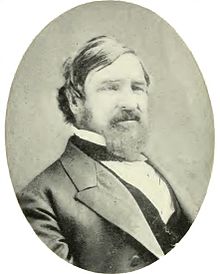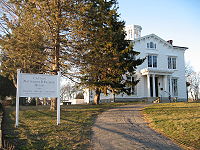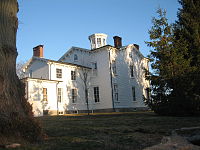- Nathaniel Palmer
-
Nathaniel Brown Palmer 
Born August 8, 1799
Stonington, ConnecticutDied June 21, 1877 (aged 77) Monuments Capt. Nathaniel B. Palmer House, Palmer Station, Palmer Land, Palmer Archipelago, N.B. Palmer (clipper), Nathaniel B. Palmer (icebreaker) Nationality American Other names "Captain Nat" Occupation Sealing captain, explorer, sailing captain, and ship designer Known for 22-year-old "Captain Nat" and his men were the first Americans to discover the Antarctic Peninsula. Later, he was active in the design of the first clipper ships. Nathaniel Brown Palmer (8 August 1799 – 21 June 1877) was an American seal hunter, explorer, sailing captain, and ship designer. He was born in Stonington, Connecticut.[1]
Contents
Sealing career and Antarctic exploration
During the 1810s the skins of Antarctic Ocean seals were highly valued as items for trade with China. As a skilled and fearless seal hunter, Palmer achieved his first command at the early age of 21. His vessel, a diminutive sloop named the Hero, was only 47 feet (14 m) in length. Palmer steered southward in the Hero at the beginning of the Antarctic summer of 1820–1821. Aggressively searching for new seal rookeries south of Cape Horn, on 17 November 1820, Palmer and his men became the first Americans and the third group of people to discover the Antarctic Peninsula. Larger ships skippered by Fabian Gottlieb von Bellingshausen and Edward Bransfield had reported sighting land earlier in 1820. Palmer also helped discover the nearby South Orkney Islands archipelago.
Merchant marine career and development of the clipper ships
After concluding a successful sealing career, Palmer, still in the prime of life, switched his attention to the captaining of fast sailing ships for the transportation of express freight. In 1843, Captain Palmer took command of the Paul Jones on her maiden voyage from Boston to Hong Kong, arriving in in 111 days. In this new role, the Connecticut captain traveled many of the world's principal sailing routes. Observing the strengths and weaknesses of the ocean-going sailing ships of his time, Palmer suggested and designed improvements to their hulls and rigging. The improvements made Palmer a co-developer of the mid-19th century clipper ship.
Palmer closed his sailing career and established himself in his hometown of Stonington as a successful owner of clipper ships sailed by others. He died in 1877, at the age of 78.
Legacy in the Antarctic and beyond
Palmer Land, part of the Antarctic Peninsula, as well as the Palmer Archipelago, were named in his honor.
The Antarctic science and research program operated by the U.S. government continues to recall Palmer's role in the exploration of the Antarctic area. Palmer Station, located in the seal islands that Palmer explored, the clipper ship N.B. Palmer (built by Jacob Aaron Westervelt) and the Antarctic icebreaker RV Nathaniel B. Palmer are named after Captain Palmer.
Hero Bay, in the South Shetland Islands, is named for Captain Palmer's sloop Hero, one of the vessels of the Pendleton sealing fleet from Stonington which visited the islands in 1820-21.
Also named after Palmer's sloop Hero is Hero Rupes, an escarpment which was discovered in the southern hemisphere of the planet Mercury in 1973.
Capt. Nathaniel B. Palmer House, Stonington, CT Capt. Nathaniel B. Palmer House, rear view with widow's walk
Capt. Nathaniel B. Palmer House, rear view with widow's walk
His home in Stonington, the Capt. Nathaniel B. Palmer House, was declared a National Historic Landmark in 1996.
Notes
- ^ Howgego, Raymond (2004). Encyclopedia of Exploration (Part 2: 1800 to 1850). Potts Point, NSW, Australia: Hordern House. http://www.antarctic-circle.org/encyclopediaentries.htm.
See also
- History of Antarctica
- Houqua, innovative early clipper ship which Capt. Nat helped design
- Paul Jones, ship which N.B. Palmer sailed on its maiden voyage
- N.B. Palmer (clipper), named after Capt. Palmer
- Capt. Nathaniel B. Palmer House
Online reading
- Spears, John Randolph (1922). Captain Nathaniel Brown Palmer: an old-time sailor of the sea. New York: The Macmillan Co.. OCLC 1834630. http://books.google.com/books?id=LPwlAAAAMAAJ&dq=%22n.b.%20palmer%22&pg=PR3#v=onepage&q=%22n.b.%20palmer%22&f=false.
External links
Clipper ships, designers & builders American-built early clippers (in year order) Anglona (1840) • Ariel (1842) • Houqua (1844)American-built extreme clippers, 1845–1850 (in year order) Rainbow (1845) • Sea Witch (1846) • Memnon (1848) • Ticonderoga (1849) • Race Horse (barque) (1850) • Sea Serpent (1850) • Stag Hound (1850) • Surprise (1850) • Witchcraft (1850)American-built extreme clippers, 1851–1855 Blue Jacket (1854) • Challenger (1853) • Champion of the Seas (1854) • Comet (1851) • Emanuela (1854) • HMS Enchantress (1854) • Flying Cloud (1851) • Golden West (1852) • Great Republic (barque) (1853) • Hornet (1851) • Ino (1851) • James Baines (1854) • John Gilpin (1852) • Lightning (1853) • Manuela (1854) • N.B. Palmer (1851) • Nightingale (1851) • Ocean Telegraph / Light Brigade (1854) • Onward (1852) • Red Jacket (1853) • Sovereign of the Seas (1852) • Sunny South (1854) • Syren (1851) • Sweepstakes (1853) • Swordfish (1851) • Westward Ho! (1852) • White Swallow (1853) • Witch of the Wave (1851) • Young America (1853)American-built medium clippers, 1851–1855 Andrew Jackson (1855) • Antelope of Boston (1851) • Carrier Dove (1855) • Carrier Pigeon (1852) • Celestial Empire (1852) • Ganges (1854) • Golden Fleece (1855) • Harriet Hoxie (1851) • Herald of the Morning (1853) • Kingfisher (1853) • Lookout (1853) • Mary Robinson (1854)American-built clippers and medium clippers, 1856–1859 King Philip (1856) • Seminole (1865) • Thatcher Magoun (1856)American-built clippers and medium clippers, 1860s Cremorne (1863) • Shooting Star (1867)British & Scottish-built "Aberdeen" clippers, 1839–1858 Challenger (1852) • Lammermuir (1856) • Lord of the Isles (1853) • Mimosa (1853) • Robin Hood (1856) • Stornoway (1850)British & Scottish-built newer style clippers, 1859–1870 Ariel (composite) (1865) • Blackadder (iron) (1870) • Cimba • City of Adelaide (composite) (1864) • Cutty Sark (composite) (1869) • Fiery Cross (1860) • Flying Spur (1860) • Hallowe'en (iron) (1870) • Lahloo (composite) (1867) • Lammermuir (composite) (1864) • Leander (composite) (1867) • Lothair (composite) (1870) • Norman Court (composite) (1869) • Serica (1863) • Sir Lancelot (composite) (1865) • Taeping (composite) (1863) • Taitsing (composite) (1865) • Tayleur (iron) (1864) • Thermopylae (composite) (1868) •Dutch-built clippers Canadian-built clippers Marco Polo (1851) • Stag (barque)American designers and builders Curtis, James O. • Curtis, Paul • Curtis, Paul & Taylor • Fernald & Pettigrew • Griffiths, John Willis • McKay, Donald • Palmer, Nathaniel • Pook, Samuel Hartt • Webb, William H • Westervelt, Jacob A.British & Scottish designers and builders Surviving 19th Century clippers Categories:- Explorers of Antarctica
- 19th-century explorers
- Boat and ship designers
- Nautical captains
- Sealers
- 1799 births
- 1877 deaths
- People from Stonington, Connecticut
- American people of English descent
- South Orkney Islands
Wikimedia Foundation. 2010.


